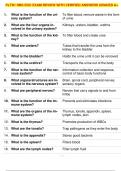Exam (elaborations)
PLTW: HBS EOC EXAM REVIEW WITH VERIFIED ANSWERS GRADED A+
- Course
- Institution
PLTW: HBS EOC EXAM REVIEW WITH VERIFIED ANSWERS GRADED A+ 1. What is the function of the uri- nary system? 2. What are the four organs in- volved in the urinary system? 3. What is the function of the kid- ney? To filter blood, remove waste in the form of urine Kidneys, ureters, bladder, ur...
[Show more]



